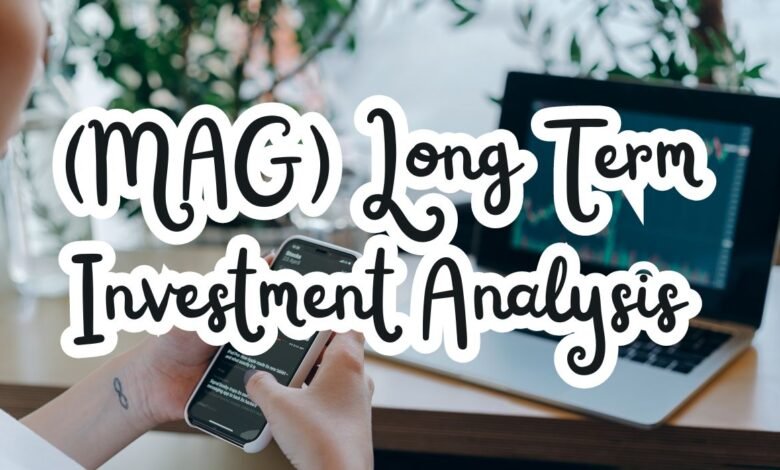(MAG) Long Term Investment Analysis
Plan for your future! Master long-term investment strategies with our in-depth analysis and secure financial success

Long term investment refers to the strategy of committing capital to financial assets with the expectation of holding them for an extended period, typically five years or more. The primary objective of long-term investment is to achieve substantial financial growth over time. This approach contrasts with short-term investment, which focuses on quick returns and involves holding assets for a shorter duration, usually less than a year.
The importance of long-term investment lies in its potential to build significant wealth and provide financial stability. By staying invested over several years, investors can benefit from the overall growth of the market, mitigating the effects of short-term volatility. This approach aligns with a more patient and disciplined mindset, where the focus is on steady, sustained growth rather than immediate gains.
A key principle behind long-term investment is the power of compounding interest. Compounding refers to the process where the earnings on an investment generate their own earnings over time. As these earnings are reinvested, the investment grows at an accelerating rate. For instance, if you invest $1,000 at an annual interest rate of 5%, you will earn $50 in the first year. In the second year, you will earn interest on $1,050, not just the original $1,000, resulting in $52.50 in earnings. Over many years, this compounding effect can lead to exponential growth in the value of the investment.
To illustrate, consider a simple example: If you invest $10,000 at an annual return rate of 7%, after 10 years, the investment would grow to approximately $19,672. However, if you leave the investment untouched for 20 years, it would grow to about $38,697. This demonstrates the substantial impact of compounding interest over the long term.
Ultimately, long-term investment is a strategy that emphasizes patience, discipline, and the understanding that time in the market is more valuable than timing the market. By focusing on long-term goals and leveraging the power of compounding interest, investors can achieve significant financial growth and stability.
Key Factors to Consider in Long-Term Investment
When delving into long-term investment analysis, several crucial factors must be meticulously evaluated to ensure a well-rounded and effective investment strategy. Each factor plays a significant role in shaping the potential success and sustainability of your investments. Below, we explore these key considerations in detail:
Risk Tolerance: Understanding your risk tolerance is paramount. This involves assessing how much risk you are willing and able to endure over the investment period. For instance, a young investor with a higher risk tolerance might lean towards equities, which, although volatile, offer substantial growth potential. Conversely, an older investor nearing retirement may prefer bonds or other fixed-income securities, which are comparatively stable but yield lower returns.
Investment Goals: Clearly defining your investment goals is essential. These objectives provide direction and purpose to your investment strategy. Whether your goal is to build a retirement nest egg, fund a child’s education, or accumulate wealth, each objective will influence your choice of investment vehicles, risk exposure, and expected returns. For example, a goal to fund a child’s college education in 18 years might lead to a balanced portfolio of stocks and bonds.
Time Horizon: The length of time you plan to hold an investment significantly impacts your strategy. A longer time horizon allows for a more aggressive approach, as it provides the opportunity to weather market fluctuations. A 30-year-old planning for retirement in 35 years can afford to invest in higher-risk assets, expecting that market downturns will be offset by long-term gains.
Diversification: Diversification is a critical risk management strategy. By spreading investments across various asset classes, sectors, and geographies, you can mitigate the risk associated with any single investment. For example, a diversified portfolio might include stocks, bonds, real estate, and international investments, reducing the impact of poor performance in any one area.
Market Trends: Keeping abreast of market trends is vital. Understanding economic indicators, industry developments, and global events can inform your investment decisions. For instance, recognizing a shift towards renewable energy might prompt an investor to allocate funds to green technologies, anticipating future growth in this sector.
Careful consideration of these factors—risk tolerance, investment goals, time horizon, diversification, and market trends—can significantly enhance the robustness and profitability of your long-term investment strategy.
Types of Long-Term Investments
Long-term investments are essential for building a robust financial portfolio. Each investment type offers distinct advantages and potential risks, catering to various investor profiles. Understanding these options is crucial for making informed decisions. Below, we explore some of the most common long-term investment vehicles.
Stocks
Stocks represent ownership in a company. As a shareholder, you benefit from the company’s growth and profits. Stocks can offer high returns, especially if you invest in firms with strong growth potential. However, they also come with significant risks due to market volatility. Stocks are suitable for investors with a high-risk tolerance and a long investment horizon.
Bonds
Bonds are debt securities issued by governments or corporations. When you purchase a bond, you are essentially lending money to the issuer in exchange for periodic interest payments and the return of principal at maturity. Bonds are generally safer than stocks and provide a predictable income stream, making them ideal for conservative investors seeking stability. However, their returns are typically lower than those of stocks.
Mutual Funds
Mutual funds pool money from multiple investors to purchase a diversified portfolio of stocks, bonds, or other securities. Managed by professional fund managers, mutual funds offer diversification and professional management, which can mitigate risk. They are suitable for investors who prefer a hands-off approach. However, management fees and expenses can affect overall returns.
Real Estate
Real estate investment involves purchasing property to generate rental income or capital appreciation. Real estate can provide a steady income stream and has the potential for significant long-term appreciation. It also acts as a hedge against inflation. However, real estate investments require substantial capital and are relatively illiquid compared to stocks and bonds. They also come with management responsibilities and market risks.
Retirement Accounts
Retirement accounts, such as 401(k)s and IRAs, offer tax advantages designed to encourage long-term saving for retirement. Contributions to these accounts may be tax-deductible, and investments grow tax-deferred until withdrawal. They are suitable for individuals planning for retirement and looking to benefit from tax savings. However, early withdrawals can incur penalties and taxes.
Advantages and disadvantages of each investment type:
| Investment Type | Advantages | Disadvantages |
|---|---|---|
| Stocks | High potential returns, ownership in companies | High risk, market volatility |
| Bonds | Predictable income, lower risk | Lower returns, interest rate risk |
| Mutual Funds | Diversification, professional management | Management fees, potential lower returns |
| Real Estate | Steady income, inflation hedge | Illiquidity, management responsibilities |
| Retirement Accounts | Tax advantages, long-term growth | Penalties for early withdrawal |
Building and Maintaining a Long Term Investment Portfolio
Constructing and managing a long-term investment portfolio requires a methodical approach to ensure it aligns with your financial objectives and risk tolerance. The cornerstone of a successful portfolio lies in a well-thought-out strategy that encompasses the selection of investments, portfolio balancing, as well as regular reviews and adjustments. Below are key strategies to help you build and maintain a robust long-term investment portfolio:
Setting Clear Financial Goals: Establishing specific, measurable, achievable, relevant, and time-bound (SMART) financial goals is fundamental. Whether it’s saving for retirement, funding education, or purchasing a home, clear goals will guide your investment decisions and help maintain focus.
Researching and Selecting Investments: Conduct thorough research before selecting investments. Consider a mix of asset classes such as stocks, bonds, mutual funds, and real estate. Evaluate factors like historical performance, risk levels, and potential for growth. Diversifying your investments can help mitigate risks.
Portfolio Diversification: Diversification is crucial in minimizing risk and enhancing potential returns. Spread investments across various sectors, industries, and geographic regions to reduce exposure to any single market’s volatility. A well-diversified portfolio can provide a more stable performance over time.
Regular Portfolio Reviews and Adjustments: Periodically review your portfolio to ensure it remains aligned with your financial goals and risk tolerance. Market conditions and personal circumstances change, necessitating adjustments. Rebalance your portfolio to maintain the desired asset allocation and consider selling underperforming assets.
Staying Informed About Market Changes: Stay updated on market trends, economic indicators, and global events that could impact your investments. Continuous learning and staying informed will empower you to make well-informed decisions and adapt your strategy as needed.
Patience and discipline are paramount in long-term investing. Avoid making impulsive decisions based on short-term market fluctuations. By adhering to a structured approach and maintaining a long-term perspective, you can build a resilient investment portfolio that supports your financial aspirations.


